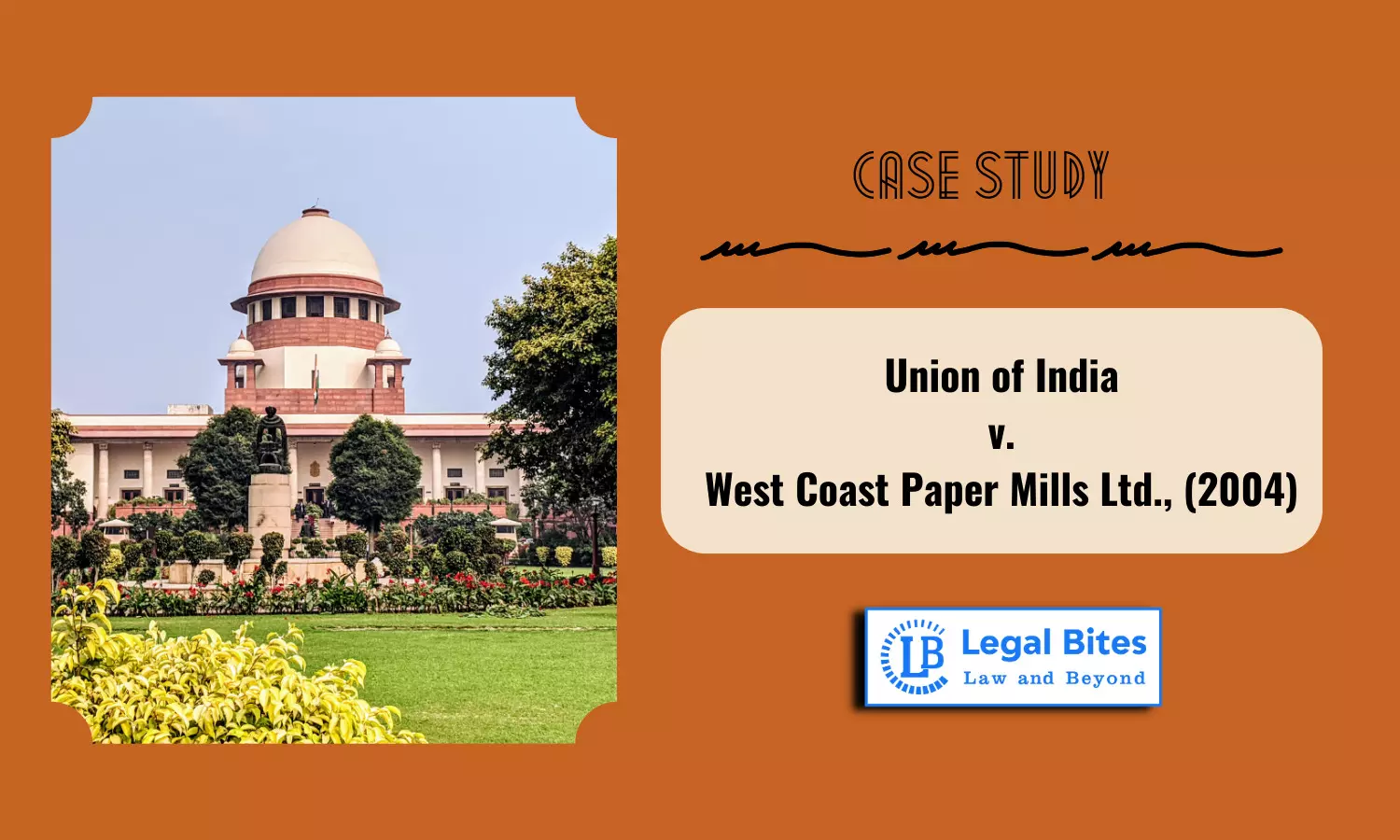Case Study: Union of India v. West Coast Paper Mills Ltd., (2004) | Period of Limitation
To gain insights into the application of the Limitation Act through a practical example, review the case of Union of India v. West Coast Paper Mills Ltd.

To gain insights into the application of the Limitation Act through a practical example, review the case of Union of India v. West Coast Paper Mills Ltd.
Court: Supreme Court of India
Case Title: Union of India v. West Coast Paper Mills Ltd.
Citation: AIR 2004 SC 1596
Petitioner: Union of India
Respondent: West Coast Paper Mills Ltd.
Judges: Justice R.C. Lahoti, Justice Ashok Bhan
Date of Judgment: 25/02/2004
Facts
West Coast Paper Mills Ltd was involved in the shipping of goods from Alnavar to Dandeli, and based on the weight of the goods the freight rate was charged. Modification in the freight rate took place on 1.2. 1964 and thus the respondent filed a complaint to the Railway Rates Tribunal. The respondent claimed that the new freight charges policies were unfair, arbitrary and discriminatory. The Railway Rates Tribunal decided in favour of the Respondent. This led to the filing of the Special Leave Petition to the Supreme Court by the appellant. The Court allowed the special leave and issued an interim order.
The Railway could charge standard rates without increasing the distance, and the Respondent must provide a bank guarantee of rupees two lakhs, renewable annually until the disposal of the appeal. On 14th October 1970 finally, the special leave petition was dismissed. The High Court did not find the matters filed in the writ petition suitable for adjudication and thus recommended the respondent to file a suit. Thus, the respondent filed two suits thereby for the refund of excess freight charges. The appellant contended that the suits were barred by limitation. Appellant referred to Article 58 of the Limitation Act, 1963 asserted that the suit must have been filed within three years from the judgment of the Tribunal. The pendency of a Special Leave Petition could not be regarded as a valid reason to exclude that period in computing the time of limitation as prescribed under the Limitation Act.
The suits were justified by the respondent in the context of Sections 14 and 15 of the Limitation Act. Both the trial court and the high court agreed that the suits were filed within the time frame prescribed in the Limitation Act
Issues
- Whether the suits were barred under Section 14 and Section 15 of the Limitation Act, 1963?
- Whether it was reasonable for the respondent to file a suit for a refund, and when did the cause of action for it arise?
Laws Applied
- Sections 14, 15, 58 and 113 of the Limitation Act, 1963, Section 46A of the Indian Railways Indian Railways Act, 1890 and Articles 136 and 226 of the Indian Constitution were applied in adjudicating this particular case.
Arguments before the Court
Appellant
The learned Senior counsel for the appellant, Mr P.P Malhotra pointed up that the Union of India had refunded the excess freight amount from the period dated 18.4.1966 to 25.9.1966 and it was in compliance with the decision of the Tribunal. Thus the counsel further stated that refund of excess freight charges from 24.6.1963 to 1.2.1964, and 1.2.1964 to 18.4.1966 were barred by Article 58 of the Limitation Act, 1963 and the respondent would have initiated the matter after the decision of the tribunal.
The learned Senior Counsel stated the tribunal's decision had to be regarded as final in terms of Section 46 A of the Indian Railways Act, and the beginning of the limitation period would be from the date of that judgment till three years. The Counsel emphasized Juscurn Boid v. Pirthichand Lal, [L.R. Indian Appeals 1918-1919 page 52], Maqbul Ahmad and others v. Onkar Pratap Narain Singh, [AIR 1935 PC 85] and various other cases to justify the aforesaid points.
Respondent
The learned Senior counsel for the respondent, Mr Harish N Salve, argued that there would be the applicability of Article 113 of the Limitation Act and thus Article 58 could not be suitable as per the circumstances. Learned Senior Counsel further stated that when the apex court granted Special Leave to Appeal in favour of appellant, allowed interim order and at that time tribunal's judgment was not final as it was in the state of jeopardy.
With the decision held in Kunhayammed v. State of Kerala, [(2000) 6 SCC 359], the learned Senior Counsel cited that in case where the doctrine of merger is applicable, the period of limitation would begin to run from the date of passing of only the appellate decree.
"Doctrine of merger is that there cannot be more than one decree or operative orders governing the same subject-matter at a given point of time."
Judgment
The Court agreed with the decision held in S.S. Rathore v. State of Madhya Pradesh, [(1989) 4 SCC 582],
The cause of action shall be taken to arise not from the date of the original adverse order but on the date when the order of the higher authority where a statutory remedy is provided entertaining the appeal or representation is made.
To get a refund of excess freight charges, the limitation period would begin from the date of order of the Supreme Court. Respondents had submitted a writ petition which was rejected and thus it was valid to exclude the duration of the writ petition. The suit was filed within the prescribed time frame. Respondent was entitled to get benefits of Section 14 and Section 15 of the Limitation Act, 1963.
Questioning the accuracy of a verdict by a two-judge panel in the case of P.K. Kutty Anuja Raja v. State of Kerala, (1996) 2 SCC 496, a Division Bench of the Supreme Court court has forwarded the issue to a three-judge panel for further consideration. It was an opinion that P.K. Kutty failed to lay down the law correctly, there was nothing discussed as to the applicability of the doctrine of merger, therefore it was overruled.

